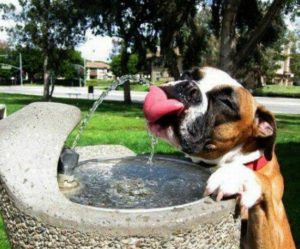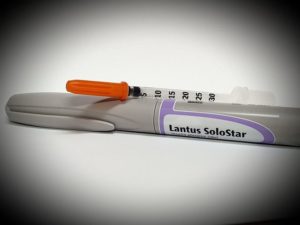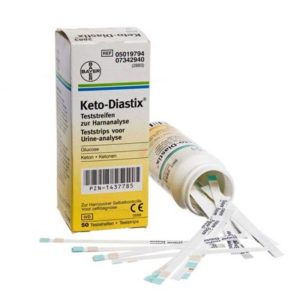
Diabetes is a manageable disease. Its cause is from the deficiency of insulin which is an important hormone made by Beta cells in the pancreas. Without proper secretion of insulin, the bloods sugars cannot regulate, thus leading to diabetes.
The 4 classic signs of diabetes your pet may show are:
- Increased water intake
- Increase urine output
- Increased appetite
- Weight loss
For glucose to enter cells and provide energy, insulin is required. Without insulin, glucose cannot complete its role and the body’s response is to begin breaking down other stores of fat and protein as an alternative energy source. Your pet’s appetite may increase as a result of this, yet may still be seen to be losing weight.
In a normal dog, the kidneys will reclaim glucose from filtered blood up to a certain level. In diabetic dogs, with large amounts of glucose in the blood, it does not all get reclaimed. The body will then begin to expel excess glucose that has not been absorbed, by excreting it in the urine.
Excess glucose in the body will attract water, resulting in the production of large amounts of urine. To avoid dehydration, you will find the dog will then drink more water.
Diagnosis of diabetes
To determine if your dog has diabetes, a vet will diagnose this based on some general criteria:
- Clinical signs
- Persistently high levels of glucose in the blood (hyperglycaemia)
- Presence of glucose in the urine
Once a diagnosis is made, the treating veterinarian will discuss a treatment plan suited to the individual animal.
Treatment
Blood glucose cannot be normalised without treatment.
-Ongoing treatment will include insulin injections, which are administered under the skin by a very small needle and these are very well tolerated by the patient. Insulin dosing pens are made for users who do not have a medical background and are easy to use. A demonstration will be completed upon dispensing the first course of insulin. The injections will be instructed to be given once or twice daily.
-It is important that insulin is stored properly and mixed well before administering. Insulin is stored in the fridge (not in the freezer), away from sunlight and inverted slowly, not shaken, just before use. Shaking the container can damage the insulin molecules.
-Regular check-ups with your vet is advised. In-clinic monitoring will ensure your pet’s ongoing treatment is optimal and ensures their quality of life. If any medication or dietary changes are required, these will be discussed with your vet. A stay at the clinic for daily monitoring will help create a “glucose-curve” and provide your vet with the information they require to determine if any changes are essential to your pet’s treatment.
Management of diabetes
For proper management, consistency is important.
-Insulin, which is usually given twice daily should be given every 12 hours.
Injections are given at meal times to help balance the glucose levels when they are at their peak. This also means that feeding regimes may also need to be altered to be given twice daily.
-It is important to note that if the dog does not eat, giving an insulin injection may cause low sugar levels (hypoglycaemia), so it is acceptable to miss an injection if the dog has no appetite. In the short term, it is better for the dog to have glucose levels too high, than it is too low. Your treating vet should also be notified of this occurrence.
-Hypoglycaemia (low sugar levels) symptoms should be recognized early as this is an emergency and should be dealt with accordingly as soon as possible. Without treatment, seizures can occur and potentially can be fatal. Low sugar levels can be as a result of the insulin dose being too high or accidentally giving too much, increased exercise or decreased food intake. The dog may act very tired/lethargic or become unresponsive. Offering a spoonful of honey may aid in raising the sugar levels within 15 minutes. If there is no response or the dog loses consciousness, seek veterinary attention immediately.
-Dietary changes should be made to allow for a high-fibre, high protein, low-fat diet. These diets will generally be lower in sugar and digest slower, meaning the body does not have to process large amounts of sugar at one time. Fibre may help stimulate insulin secretion. Your treating veterinarian will discuss dietary recommendations at the time of your visit.
Home monitoring
For best control of your dog’s diabetes, home monitoring can be recorded. Your treating vet will provide you with a record sheet (Click here for additional Diabetic Monitoring Chart), keto-diastix and instructions. Monitoring over time allows the diabetes to be well controlled by having a visual representation of what is normal or abnormal for the dog.
Information that your vet will request to be recorded includes daily food intake, daily water intake, keto-diastix recordings, demeanour, and weight.
Any change in daily recordings can provide an owner with information that may lead to an earlier recognition of the animal being unwell or that the diabetes is not being well controlled.
Keto-diastix provide a fast, convenient way of testing urine at home, for the presence and concentration of glucose and ketones. Ketones are produced when the body burns fat for fuel. Normally these ketones will be completely metabolised so that there are very few ketones in the urine. If for any reason the body cannot get enough glucose for energy it will switch to using body fats, causing an increase in ketones in the body. This results in more ketones present in the urine.
With regular check-ups and home monitoring, diabetes can be well controlled which will give you a happier and healthier dog.





